HUD removes 2025 NOFO temporarily
(December 2025) The Department of Housing and Urban Development has removed the FY 2025 CoC NOFA early this week. The pause in the NOFO occurred Monday shortly before an initial hearing on two lawsuits - one brought by the National Alliance to End Homelessness and other nonprofit groups and one by Democratic Attorneys General. The HUD NOFO released weeks ago contained significant priority changes as well as language addressing the ineligibility of funding for programs and agencies that accept or promote non-binary genders. The funding levels themselves were not reduced and essentially remain at levels similar to the Biden Administration with small increases adjusting for inflation due to rental cost increases. The exact words on the HUD website read:
The Department has withdrawn a Notice of Funding Opportunity (NOFO) with respect to the Continuum of Care (CoC) grant program. This withdrawal will allow the Department to make appropriate revisions to the NOFO, and the Department intends to do so. In the previous FY 24-25 NOFO, the Department reserved the right to make changes to the NOFO instead of processing renewals for a variety of reasons, including to accommodate a new CoC or Youth Homelessness Demonstration Program (YHDP) priority or new funding source. The Department still intends to exercise this discretion and make changes to the previously issued CoC NOFO to account for new priorities. HUD anticipates reissuing a modified NOFO well in advance of the deadline for obligation of available Fiscal Year 2025 funds.
Nashville Mayor Freddie O'Connell, a city that is part of the lawsuit, said “This is a life-or-death situation.” He told local station News Channel 5 Nashville. “We are taking them to court to stop it.” He added that it felt like intentional chaos from the Trump Administration.
Jefferson Public Radio in Southern Oregon reported that Heyleigh Strempel, Director of housing and community services in Northern California said, "Permanent supportive housing is meant really to sustain households that cannot be housed otherwise. Those are the hardest people to house with the highest barriers. So a reduction in permanent supportive housing across the nation would have big impacts," she said. "However, there is a big need for more transitional housing and detox and substance use recovery centers. So I don't know that cutting one and funding another or vice versa is going to maybe solve the problem."
HUD has given no timeline for reissuing the NOFO.
* * * * *
Household Deformation: The Rise and Permanence of Modern Homelessness
(July 2025) NHIP Publisher Michael Ullman, Ph.D. has released his new book entited "Household Deformation: The Rise and Permanence of Modern Homelessness". It is for sale on Amazon in paperwork and kindle reader. Dr. Ullman has worked nationally in low-income housing and homeless services for over 30 years.
The book exposes how the media, advocates, and government officials continue to confuse the public about modern homelessness and the reasons for its growth and continuation despite billions of dollars funded by federal, state, local, and public donations.
Using stories, statistics and the sociological imagination, Household Deformation debunks the affordable housing thesis and explains how the rise in single adult households fueled by societal norm changes and anti-family federal low-income housing policy has precipitated the rise in homelessness over the past 50 years. Ullman also shows how the federal definition itself confuses the public about who is housed and who is not and creates the persistently high levels reported.
For readers of the NHIP monthly briefs, reports and editorials, the arguments and research presented in the book will be familiar, while providing a more comprehensive set of evidence backed by stories from people caught in the system.
Household Deformation is for anyone who wants to understand homelessness beyond the current simplistic public dialogue.
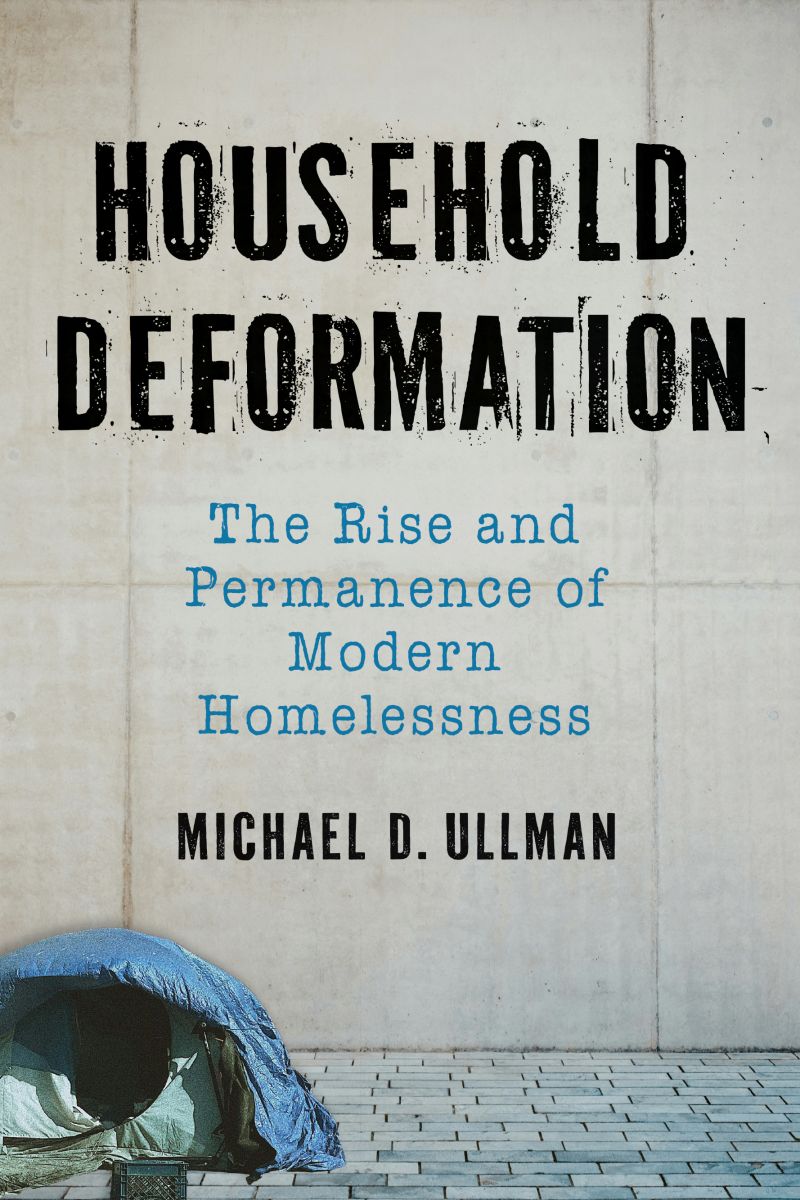
* * * * * * *
Boston CoC remains best in Housing Proficiency among Major Cities
(April 2025) Reviewing Housing Efficiency for the 48 Major City CoCs finds that Boston (99%) followed by Baltimore (98%) Milwaukee (98%) and New York City (98%) have the highest ratings due to the provision of significant housing opportunities with few people remaining unhoused on the street. New York also ranks high due to the provision of housing to 187,770 persons despite recording 4,397 unsheltered. Below is the chart for all 48 Major City CoCs. Boston retains the #1 ranking for the 2nd straight year. The NHIP revised its methodology for 2024 by including persons served with Permanent Supportive Housing (PSH)and Rapid ReHousing (RRH) on the PIT 2024 one day count. The vast majority of federal funding goes to support these programs (RRH/SHP).
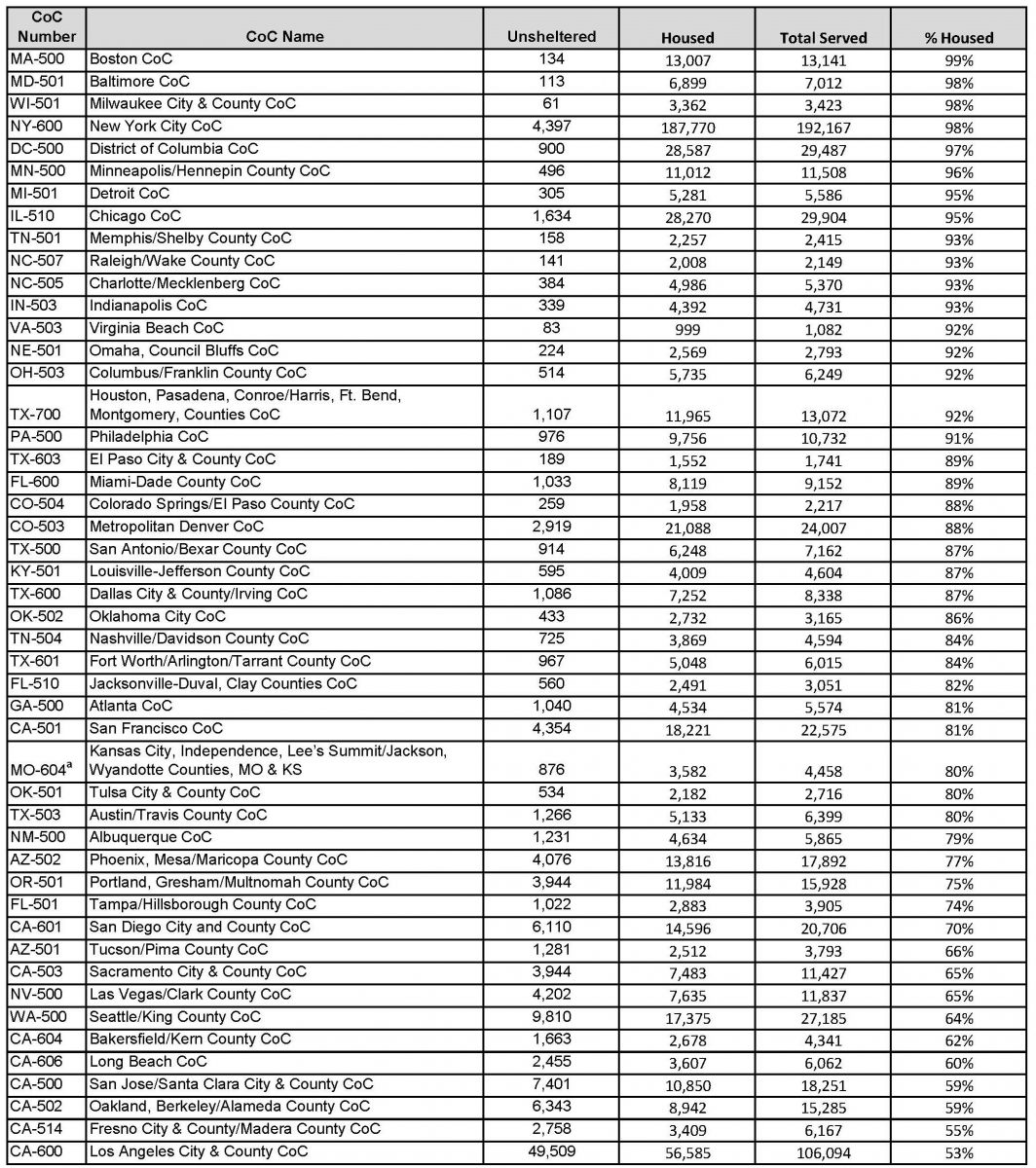
The six CoCs with the lowest efficiency ratings are all California CoCs including Long Beach, San Jose, Oakland, Fresno and Los Angeles. The NHIP notes that San Francisco's rating of 81% is just above the national average of 80% and ranks as the best performing of all the CA CoCs. The known issue of significant numbers of unsheltered persons on the West Coast influenced by the milder winters during the time of the annual count certainly impacts rankings. There are mild or warm weather cities that do rank above average including Houston (92%) and Miami (89%). The NHIP believes that if solid data were available on the numbers of single adult households in each CoC catchment area, it would show a strong relationship to the level of homelessness.
The extent of the difference between unsheltered counts in the winter versus summer are unknown since only a handful of cities have ever done both in the same year. It is presumed that cold weather cities will have more people living outside during the summer. The burden of cities with warm or mild winters should not exempt them from improving their housing efficiency. While climate appears to be a large factor, there are other factors since warm weather states like Florida and other southern states do not have as high of numbers.
See the list of all CoCs Housing Efficiency 2024 rating.
* * * * * *
HUD Funding Inequities Persist in 2023 Awards
(February 2024) An analysis of McKinney Vento Homeless Assistance funding awarded recently for FY2023 continues to show enormous inequities between states especially compared to homeless prevalence. Comparing total funding of $3.15 billion with the most recent PIT count of 653,104 yields a funding per capita (count) of $4,384. The top 5 and bottom 5 states in funding per PIT capita are as follows:
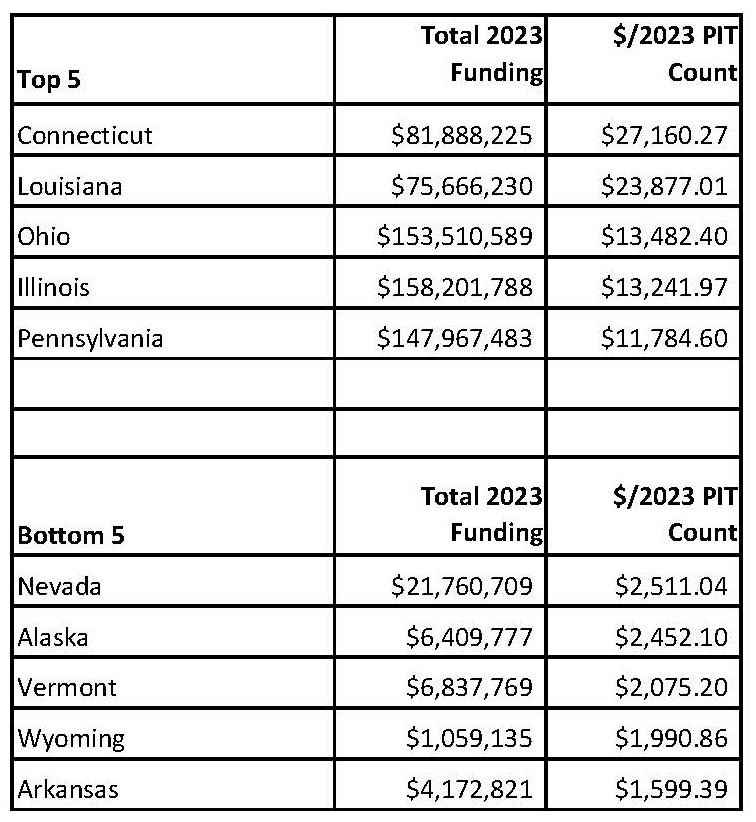
A good example of the massive inequities can be seen comparing the State of Oregon which receives $60 million in homeless assistance and has reported an estimated PIT2023 total of 20,000+ persons with Ohio which receives $153 million and has an estimated PIT of 11,000+ persons. These inequities are further compounded by the fact that many of the CoCs with high per capita funding have lower housing costs.
It is interesting that HUD seems so fixated on addressing inequities, but it does not address the most fundamental inequity that resides in its own house. The VA also does not address inequities in its GPD funding - although its staff receive their COLA. CLCK HERE for the full 2023 Funding Per Capita report.
* * * * * * *
PIT 2023: More errors and humbug
(December 2023) The NHIP has compiled a chart comparing PIT 2022 with the recent PIT 2023 numbers for the following totals by CoC :Total Homeless, Total Emergency, Total Transitional, Total Safe Haven, and Total Unsheltered. Key highlights from this chart and the overall PIT data include:
- The NHIP appears to have identified a potential error in the official PIT count comparison. The 2022 PIT count included a homeless count of 1,205 unsheltered individuals from the Northern Mariana Islands (NMI). The 2023 PIT count does not include any information from the NMI CoC. Any comparison between 2022 and 2023 must take into account this missing data. Taking out the NMI 2022 PIT count, the number of unsheltered homeless went up 10.3% not 9.7% as documented in the AHAR report and publicized in the media. Similarly, the overall PIT increase would be 12.4% not 12.1%. If HUD or AHAR officials have any comment about this issue, please contact the NHIP. Or otherwise update your reports.
- 26 CoCs including 17 CoCs from CA did not complete a 2023 unsheltered count. Key large CoCs including Bay Area CoCs of San Fran, Oakland, Sacramento, Santa Ana, Marin and Humboldt Counties. Outside of CA, the cities of Seattle and Detroit also did not complete an unsheltered count. The Bay Area CoCs not completing an annual unsheltered count is pretty miserable considering UCSF is home to the Benioff Institute for Homeless and Housing Initiatives whose mission is focused on empirically-driven research on homelessness.
- Failure to complete 2023 unsheltered counts at 26 CoCs likely further underestimated the rise in unsheltered homelessness.
- HUD continues to provide no information on the number of two-parent couples with children experiencing homelessness. This data is important because multi-adult households with or without children remain the best prevention for homelessness by a factor of over 100x.
- A total of 2,028 persons were reported as residing in Safe Havens. It should be explained that over the last couple years, the VA has requested that its GPD-Low Demand program track be categorized as a Safe Haven program. The VA low demand track is a much different type of program than the original Safe Haven program which the NHIP editor has worked with in the past. The Safe Haven paradigm provides a significantly higher amount of support (higher staff ratios and greater funding) than the GPD-Low Demand program in addition to many other differences. If there any providers who would like to chime in about their thoughts on GPD Low Demand as a Safe Haven, please contact the NHIP. Some anecdotal inquiries by the NHIP seem to support the fact that many GPD programs are not aware that these beds are considered as Safe Haven beds.
- Females represented 30% of the overall unsheltered count. Four CoCs (FL-517=62% ,FL-506=56%, NY-501=53%, SC-503=50%) reported females representing 50% or greater of their unsheltered counts. Among large CoCs, DC, Atlanta and Houston reported the highest male unsheltered proportion between 78% to 81% of the total unsheltered count.
- The number of persons residing in housing defined as "homeless transitional" crept up by 4,104 to 65,521. The AHAR notes that a significantly number (15% to 20%) of transitional housing beds were open/unused at the time of the count. The NHIP has maintained that people living in transitional housing should not be defined as homeless since their accommodations do not differ in any meaningful way than people living in rental housing.
If persons are interested in the 2022-23 PIT data comparison file in EXCEL format so they can do their own sorting for analysis purposes, please contact the NHIP via email.
* * * * * * *
USICH/HUD misinterpret homeless mortality data
(January 2024) The USICH is currently misinterpreting results from reports on mortality among homeless persons. The figure below shows what the USICH is publishing on its website stating that the average age of "people who experience homelessness die nearly 30 years earlier than the average American". There is no citation with their graph. A search of the internet appears to show that this information may have come from the 2019 report from Sacramento that showed a shortened life expectancy of people who were homelessness living on the street at the time of their death which was later cited in the publication Homeless Mortality Data Toolkit in 2021 by the National Health Care for the Homeless Council which cited other reports from cities with similar data.
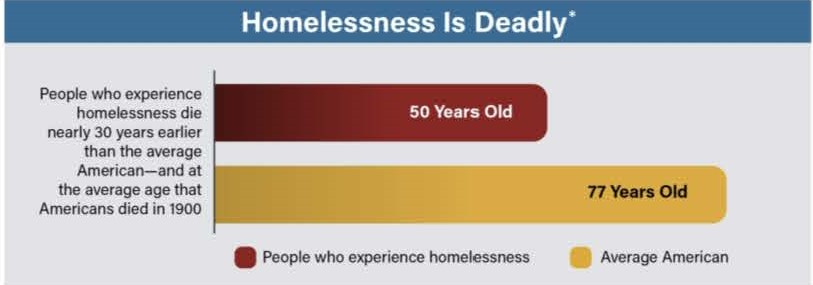
The key information in the Sacramento report can be found below which states in the lower left that the average age of homeless male deaths was 51.9 years and homeless female deaths was 43 years. Since males outnumbered females 3:1, the average of all deaths was approximately 50 years.
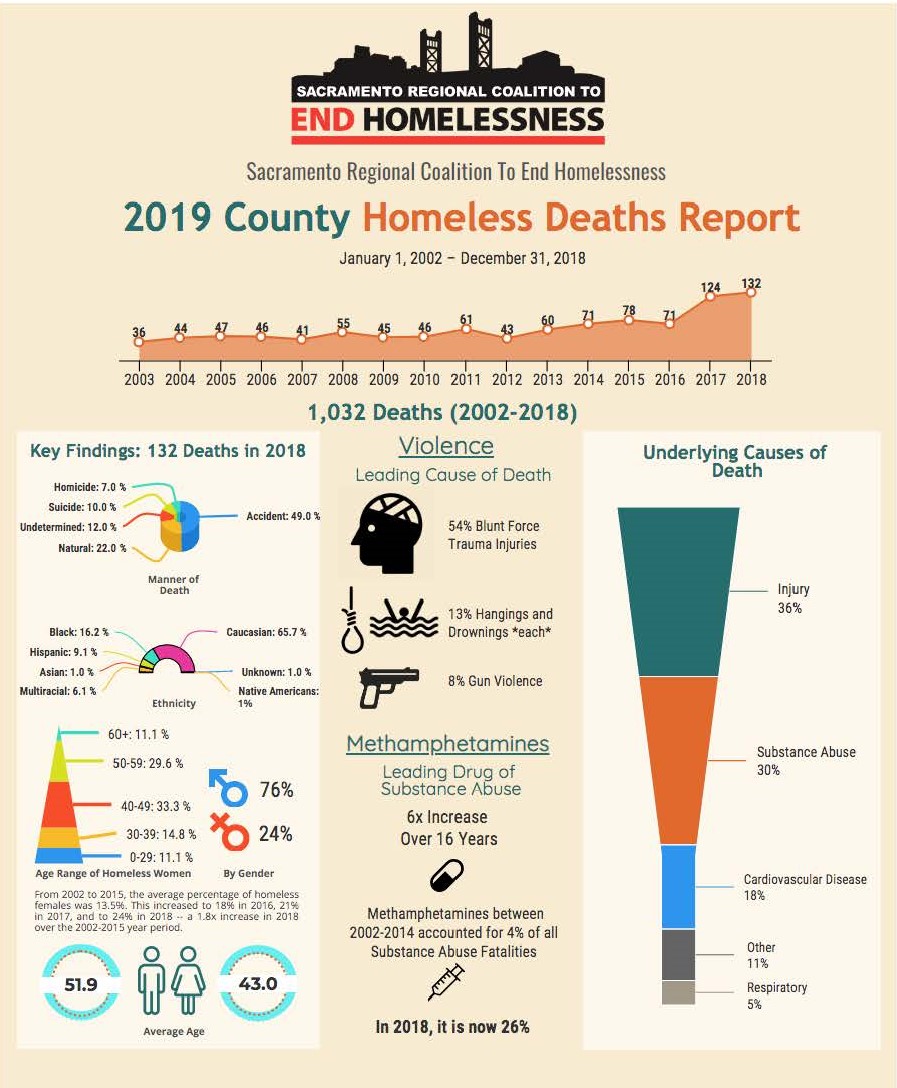
A close review of the Sacramento report and the NHCHC publication by the Dr. Michael Ullman, NHIP Editor, who is a research methodologist, yielded the understanding that these data reflect persons who died while living on the streets, not all homeless persons or all persons experiencing homelessness. The information itself comes from corner's reports. This is, of course, a very important distinction. While the data is very important, it is a world of difference than stating the average longevity of persons who experience homelessness is 52 years for men and 43 years for women.
To understand the data presented, one would need to compare the "street deaths" of those non-homeless with those homeless which would likely be much lower than the average age of all deaths. Or compare the deaths by injury or overdose among housed and non-housed people. While not being housed is a problem, clearly the former is the greater issue. Most studies including mortality data reviewed by Dr. Ullman show an average shortened life expectancy of closer to 10 to 15 years among persons with a significant period of homelessness. Certainly, persons with a short stint of homelessness do not lose 25 to 30 years of their life. These data are not even collectible since questions about history of homelessness is not gathered at the time of death for people.
The inability or unwillingness of these government reports and the USICH and HUD partners to clearly make this distinction is very troubling. Does the USICH understand the difference? The lack of a citation in the USICH website for such a important statistic is also unacceptable. You don't have to convince people that living on the streets is a problem - no spins necessary.
The NHIP hopes the USICH for publish a clarification on their website and appropriately citations. If anyone - especially HUD and USICH readers - can explain further the mortality data presented, the NHIP welcomes their response for clarificatio
********
NHIP Analysis finds Oahu Continuum PIT report greatly underestimated Homeless Veterans in PIT 2022 and 2023
(December 18,2023) In a review of the recent release of Annual Homeless Assessment Report 2023 Part 1 by HUD which reported a large 12.1% increase in homelessness across the country and a 7.4% increase in veterans homelessness, the National Homeless Information Program (NHIP) has found that the number of homeless veterans (active duty and non-active duty) reported by the Oahu Continuum of Care point-in-time (PIT) homeless data is likely underestimated by as much as 100% due to errors and/or exclusions in the PIT 2022 and 2023 reports.
The Oahu PIT 2022 reported a total of 228 homeless veterans including 101 unsheltered veterans, while the more recent 2023 report found 261 homeless veterans including 108 unsheltered veterans. A review of the data by the NHIP found that the unsheltered veterans total was taken from a 37% sample in 2022 and a 49% sample in 2023 without any extrapolated estimate for the entire unsheltered population. The 2023 sample questioned 1,161 unsheltered persons about veteran status representing 49% of the total 2,365 unsheltered population. The 2022 sample questioned 874 out of 2,355, or 37% of the total unsheltered population.
An estimation of unsheltered veterans that assumes an equal number of veterans among those surveyed compared to those not surveyed would yield 269 unsheltered veterans in 2022 and 220 unsheltered veterans in 2023. Total homelessness among veterans would rise to 396 and 373 in 2022 and 2023, respectively. The true figure would likely vary from this linear extrapolation but would be significantly higher than currently reported.
The NHIP had alerted the HUD field director as well as the Oahu Continuum of Care about these data problems in August 2023. There is currently no quality review performed by HUD on local homeless point in time counts. The NHIP finds errors in a majority of reports it reviews around the country that are made publicly available. The NHIP has written extensively about how much of the reported large decrease in homeless veterans and unsheltered persons during the 2007 to 2015 was due in large part by poor quality homeless counts including large overestimates in several cities.
In addition, the VA and HUD began in 2020 to omit non-active duty military personnel as veterans in the homeless count which is why HUD further decreased the total number of homeless veterans as reported by the Oahu Continuum of Care from 261 to 226 in 2023 and from 228 to 198 in 2022.
The NHIP also noted in its review of the Oahu Homeless Count reports that only 24% of all unsheltered persons surveyed had an active record in the Statewide Continuums Homeless Management Information System. This low percentage is reflective of poor implementation of the Coordinated Entry System which has the objective of engaging and prioritizing all persons experiencing homelessness especially those living on the streets.
The National Homeless Information Project (NHIP) is a volunteer-run initiative that disseminates information nationally about homelessness and advocates for a better understanding of modern homelessness. Modern homelessness cannot be explained as a problem of affordable housing, but rather is singularly fueled by the rise of single-adult households, changes in societal family norms since the 1960s, and anti-family HUD housing subsidy policies.
************************
Modern Homelessness: Product of societal changes, political definitions, bad policy and anti-family government regulation
(Honolulu Star-Advertiser, July 9, 2023) GUEST COLUMNIST - Michael Ullman, Ph.D.
The most recent homeless point in time count by the Continuum of Care program on Oahu and the neighbor islands continues to show high levels of unsheltered homelessness, as documented now for more than 30 years since the first official Hawaii homeless census in 1991. These counts that appear to demonstrate little to no progress vex both those working in the field, and perhaps even more so, regular citizens who have to live in a community with such numbers of visible homeless people. This frustration could be ameliorated if a better and more holistic explanation of the phenomenon of modern homelessness was understood.
There are two challenges with the homeless population: 1) housing those who are homeless — which homeless providers have done very well over the last 30 years; and 2) stopping the flow of new people into the ranks of the homeless. Addressing the second issue is beyond the ability of government, nonprofit agencies, or anyone else that tries. A hospital can mend broken bones from car crashes, but it cannot impact how many crashes occur. The tired conventional wisdom centering on the lack of affordable housing continues to offer a poor explanation since it lacks a wider ecological perspective.
A simple look at the different rates of homelessness among whites and Native Hawaiians compared with Japanese, Chinese and Filipinos in Hawaii and on the mainland reveals another factor in the homelessness equation. People who cannot afford their own housing are supposed to live with (or return to live with) their families. Homelessness is much lower (three to 10 times) among populations that still maintain these large family support networks.
Understanding homelessness demands a more historical understanding of the trends of household formation and composition. The key change in household formation since the 1960s is the rise of single adult households either via divorce, never marrying, or simply out of choice due to the relaxation of strict family and gender norms which previously offered a safety net. The more single adult households you have, the more homelessness will exist. It is really that simple. The last few decades have seen the rise of freedom from previous norms. Freedom begets chaos in a neutral sense. Homelessness is just one of the characteristics of this freedom from norms.
Another issue that confuses people is the definition of homelessness itself, which defines people living in housing ranging from a dormitory at the Institute for Human Services, a four-person barracks room at U.S. VETS, or an apartment with a two-year lease at Catholic Charities’ Maili Land transitional housing complex as sheltered homeless. Such housing offers everything and more than an apartment does, and often at a fully subsidized price. The only real distinction between this housing and regular nonhomeless housing is limited privacy.
The other issue that gets lost in the details of homeless programs is the anti- family policies of the U.S. Department Housing and Urban Development (HUD), which effectively deters the ability of housing-voucher holders to allow family members or friends to live in their HUD-supported unit. It is normative to share housing with others, and it is culturally appropriate to allow people to let their ohana come live with them for a month, a year or however long needed.
It is extremely difficult for people to give up the belief that affordable housing is the key driver of homelessness. Providers see it because they try to house homeless people in their own apartments instead of urging them to go back to family or putting them in shared housing at half or sometimes a third of the cost. The vast majority of people who are homeless would not benefit from affordable housing, because they essentially need free housing since they can barely pay $200 a month in rent.
Until people understand how changes in household formation and relaxation of societal norms are the primary drivers of homelessness, and until advocates, politicians and regular citizens recognize that homeless agencies and local governments are powerless against these characteristics of modern society, frustration will loom unimpeded.
* * * * * * * *
HUD Funding Disparities continue unabated - NHIP Report
(June 2023) The NHIP has revised its CoC 2022 Funding Per Capita Disparities Analysis previously completed in 2016 and 2019 using the latest complete data from the PIT 2022 and the CoC PY2022 funding awards. Results show similar trends from previous analyses revealing wide disparities in funding when compared to homeless levels ranging from $48,316 in MI-502 Dearborn/Dearborn Heights to $17 in CA-524 Yuba/Sutter County. Dearborn receives $8M on 166 PIT homeless, while Yuba receives $18,000 (essentially planning funding) for over 1,000 PIT homeless. Dearborn also has reported zero unsheltered homeless during 2022 and less than 25 in years prior to COVID restriction.
While these are extreme examples, the trend in funding continues to be heavily influenced by the original formulae which allocated funding based on arcane measures that favors old NE cities and rust belt areas. That said, in theory if CoCs have received more funding over the years, results should see a decrease in homeless and therefore an increase in funding per capita since HUD funding today essentially covers Permanent Supportive Housing and costly infrastructure for CES implementation. While this may have occurred in a few CoCs, there has generally been no linkage found between homeless funding and homeless prevalence due to new inflows which complicate the analysis.
Two additional factors have impacted the levels of funding at individual CoCs. During the late 1990s and 2000s, CoCs with superior applications were awarded bonus projects. This practice essentially ended in the early 2010s. In addition, CoCs that sought funding for housing voucher programs like Shelter Plus Care received large increases due to increases in FMR over the years.
Overall, the average HUD CoC funding per capita is $4,741. The Los Angeles CoC received over $157M - the most of any CoC - which translated into only $2,424 per capita. Other large cities include San Francisco ($6,838), Chicago ($22,331), Miami ($12,686) and New York City ($2,387). The NHIP points out that disparities are actually underrepresented by this analysis since it does not take into account the cost of housing in each CoC which can be 2 to 3 times higher than in many areas of CA, DC, and CT compared to Midwest states like Oklahoma, Missouri and Southern states like Tennessee, Alabama, and Mississippi.
The NHIP has also recommended over the years to use bonus or new funds to mitigate some of the extreme disparities to no avail. HUD has had many chances to reduce these disparities but has chosen not to address the issue. Even the most recent new Outreach funding did not target these disparities effectively with states like Illinois receiving over 12% of the funding while accounting for only 1.3% of the nation's unsheltered count. The table below shows the Top 10 CoC by Funding per Capita.

* * * * * * * * * * * *
What Bill Walton doesn't understand about homelessness (and it's not his fault)
(January 2023) NBA legend Bill Walton and George Mullen, CEO of the Sunbreak Ranch, offered an approach to help end homelessness in an editorial published in the Times of San Diego this past weekend. They called for 2,000 acres of government land outside of San Diego to be used for a new "tent city" area with amenities for homeless people to relocate and live relatively unfettered. This approach was to be replicated outside of many cities.
While the effort is laudable, although immediately attacked by some, Walton's approach is ba sed on the same wrong-headed information that still dominates the national homeless dialogue. Bill - you need a new coach to explain the fundamentals of homelessness that the media and "experts" will not provide - and I am here to help!
"It's like this, Bill. The offense is scoring 120 per night, but the defense is giving up 125+."
Mr. Walton and Mr. Mullen, the public, politicians, policy makers and the homeless industry still confuses the difference between offense (helping currently homeless people find a place) and defense (preventing new people from entering the ranks of homeless living). While the pick n' roll is a great offensive strategy, it will not stop Steph Curry on the other end from getting an open three and winning at the buzzer. The offense is fine. Homeless services is great at housing people who are experiencing homelessness - it is not a failure – it houses 350,000+ individuals plus each year and keeps 500,000+ from going back to the streets. .
Increasing the salary cap could house more people. But it can't house everyone of course, because just like in basketball, there are rules like the Bill of Rights and the Constitution. In the NBA, you can't just charge into your defender to score or grab a scorer driving to the bucket. That's a flagrant foul. America also has rules (laws) that prevent you from doing just that to homeless people in many public spaces. And if you add an expansion team like your proposed Sunbreak Ranchers, even if you are willing to pay KD or Joker way big money, they ain't gonna come play for your team at your new arena. They like it where they are. Well, KD not sure.
It's like this, Bill. The offense is scoring 120 per night, but the defense is giving up 125+. The answer is not scoring 130 since the opponent can score 135-140 especially since some of the plays give an easy transition to your opponent. Yes, we have a losing record, but we not the 1972-73 76ers. it’s not because we don't have a good inside game. San Diego had 3,000 dunks last year (people housed). But we need to block more shots (i.e. prevent new people from entering homelessness), and a lot of new norms, bad policies, and poorly understood definitions of homelessness are hurting us on defense and making us look bad in the press.
Improving our defense and stopping the other team from scoring, that is, preventing new people entering homelessness is a completely separate issue and it is one that is beyond the scope of any one team, non-profit or homeless coalition. You see there is a new kind of game. College ballers think they are all one and dones. Sure, you and Kareem could have left college early had the norms been different, but today too many recruits leave college (people leave family homes) and can't even get picked up by the G league!
You see society has moved from a concept of multiple adult households - since most adults cannot pay the rent alone which is why most people share housing with family or friends or just roommates they don't even know - to one where single adult households are almost the predominant form. This began in the 60s/70s and is the new norm - through divorce, never marrying, and not wanting to return to the family home when they run out of money, and for many not wanting to share a locker room with others.. People without means are supposed to go back to family or friends and obey a few rules as a house guest. Luckily, many still join a team, but too many don't and too many of those become homeless.
Worse yet, the "game" now has rules that limit teams to only 5 players and only one center. In policy terms, the housing subsidies that are given to millions of very poor and homeless households prevent them from allowing other friends and family who are or maybe homeless from staying with them. It's called the Brooke Amendment. You can look it up. Can you imagine when the Celtics had offered you a spot on the roster in 1985 and the league said "No, you have your five!" Like Parish could have gone all 48 minutes!
Lastly Bill, remember when there was an ABA and NBA. Okay, the NBA was probably superior overall, but the ABA had great players (Erving, Gilmore, Barry) and good teams. Imagine if the NBA said that the ABA was not basketball and refused to allow these players to add those points to their career totals. Well, that is essentially what the federal government does. About 60% of "homeless" people are housed. They just don't have the "digs" of the better housing. They do live in housing, sometimes shared, or congregate or even some private units with a key. In San Diego, about 55% of the homeless population are housed including about 20% who have their own apartment. We just call them homeless cause "they have to share a locker room" basically. Some people complain about the condition of the stadium (house) these people live in - but they don't seem to want to make it nicer. Do they deserve a better arena? That's up to the fans (community) to demand it and owners (government and other funders) to build it.
You see, Mr. Walton. I really am sorry for the poor coaching on homelessness you have received. I'm sorry we don't have instant replay to see all these miscues the refs are making. As one of the all-time great defensive centers, I know you will now better understand the problem and want to know more. Maybe you can help me talk to the commissioner (HUD). And although I'm not Riley, Auerbach, and certainly not Mr. Wooden, I can teach you some fundamentals of homelessness. My next camp starts soon!
* * * * *
Whites show lower shelter accessibility than Blacks
(January 2023) A review of the sheltered and unsheltered numbers for individuals in the PIT2022 census shows that White persons who are homeless have 63% lower odds of using emergency shelter services compared to Black persons who are homeless. While 59% of white persons are unsheltered, only 47% of Black homeless individuals are unsheltered. The analysis did not include persons in transitional housing. Virginia Beach, VA offers a good example of this accessibility issue.
Among the 133 shelters individuals, 65 were White and 68 were Black for a near even proportion. Among unsheltered persons, the PIT reported 40 Whites and 8 Blacks. In Virginia Beach, Black persons had 5 times greater odds of utilizing shelter place compared to White persons. Shelters in both New York City (2.13 greater odds) and Seattle/King County (1.60 greater odds) also were more accessible to Black individuals compared to White individuals experiencing homelessness. Some cities showed a reverse trend like Chicago, Salt Lake City, and Los Angeles where Blacks had lower shelter accessibility odds (less than 1.0) than Whites.. A complete listing can be found under the Homeless Data reports menu.
While publications have focused on the over-representation of Blacks in the homeless population compared to their general population representation in the U.S., almost no coverage has pointed out the disparities in shelter accessibility by race. More attention should be paid to ensuring equal shelter access for all race groups.
Location of shelters (urban vs. rural) may be a factor in the Black to White disparities. There is not enough data on the PIT to perform this type of analysis. Balance of State CoCs were represented as both race accessible and inaccessible. Some accessibility differences may not be salient as in Washtenaw, Michigan which showed a 4x lower likelihood of whites utilizing shelters, but the total unsheltered White population was only 5 persons compared to 1 Black person.
* * * * * *
New gender listings proposed by HUD
(November, 2022) HUD is requesting feedback on the data elements under the proposed changes for the HMIS race, ethnicity and gender questions. Below are HUD's suggested changes for the gender element.
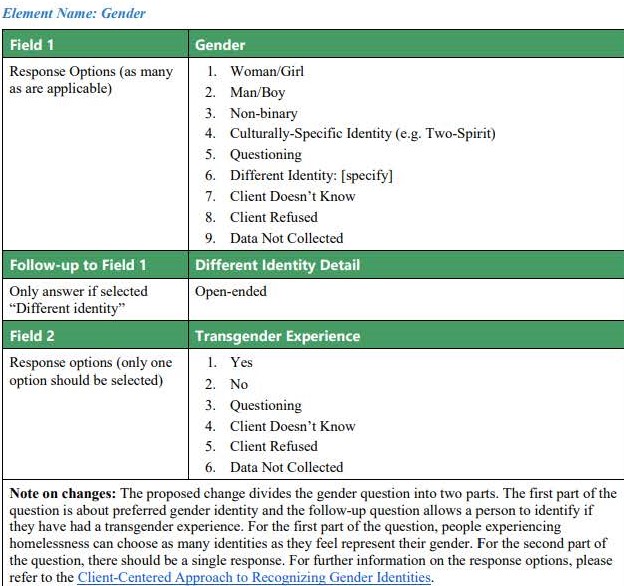
From a statistical and research point of view, all responses other than singular woman or man are not needed, since the responses make up only 0.5% of all responses (AHAR 2020) and are too heterogenous for any analysis. Any meaningful analysis would just lump them as an other category. This type of complex gender identification information should be collected through case management discussion as it relates to the person's needs, psycho-social stability and unique challenges. The additional data burden on the system compared to the value of the data points have yet to be shown. Meanwhile, the HMIS still does not require collection of information on the parents, siblings, spouses, or children not with the homeless adult and the family members' ability to support this family member in need.
In comparison to the unlimited combination of responses for the multi-tiered gender questions, the question on race/ethnicity continues to lump a massively heterogeneous mix of people the government calls Hispanic/Latino - of whom refer to themselves as Hispanic/Latino - and have only adopted the label as a convenience for these census questions since they don't give any additional choices for their actual ethnicity. The same is true for Whites. Try telling a person of Greek heritage that they are similar to the French.
***********
* * * * *
HUD releases PIT 2019 veteran counts
(November 2019) HUD released veterans data from the most recent PIT 2019 homeless one-day count completed by the 400 CoCs around the country. Results showed a small decrease from 2018 to 2019 in total one-day homelessness from 37,878 to 37,085. Thirteen CoCs reported drops of 50 veterans or more, while 10 CoCs reported increases of 50 veterans or more.
The TOP TEN CoCs reporting the greatest decreases from 2018 to 2019 included:
San Diego (-244)
Texas BOS (-127)
Pasco County, GL (-122)
Santa Ana/Anaheim (-108)
Chicago (-95)
Santa Cruz/Watsonville (-94)
Seattle (-91)
Colorado BOS (-75)
Imperial County, CA (-69)
Houston/Harris County (-69)
Top 5 Veteran Homeless PIT Increases (2018-2019)
Sacramento (+175)
Oakland/Alameda County (+166)
Dallas (+111)
Louisville (+98)
Georgia BOS (+96)
The one-day homeless totals include over 10,000 veterans residing in VA-funded housing programs including the Grant and Per Diem transitional program and VA Emergency or Respite Bed programs.
Click for a full listing of Veteran PIT 2019 by CoC sorted by greatest decrease.
* * * * *
Help with Racial Equity Analysis for Exhibit 1
(August 2019) Below are the two excel files that can run racial equity analyses:
1) HUD Racial Equity Tool - Using PIT information to compare overall population prevalence and poverty prevalance with homeless service utilitization prevalence.
Copy of Sample Racial Equity Tool for DuPage County formatted to fit one page. You will need to UNPROTECT the spreadsheet to manipulate formatting. Click here for sample narrative analysis.
2) NAEH Racial Equity Outcomes Tool - Using HMIS annual utilization and outcomes data to measure equity of positive outcomes by race/ethnic groups. CLICK HERE for sample data and narrative analysis.
3) NHIP Staffing Equity Tool - Using a modified version of the NAEH tool, CoCs can calculate a staffing equity analysis.
* * * * *
San Fran, Oakland, San Jose Report Large Homeless Rises
(May 2019) Preliminary reports released by Continuums in San Francisco, Oakland, and San Jose showed signficant increases in the one-day estimate of homelessness in comparison to their previous 2017 counts.
San Francisco: 17% from 6,858 (2017) to 8,011 (2019)
Oakland/Alameda County: 43% from 5,629 (2017) to 8,022 (2019)
San Jose/Santa Clara County: 35% from 7,294 (2017) to 9,706 (2019)
Full reports on the breakdown of the 2019 PIT count have not yet been released. It is important to understand the differential changes among people living in shelters, living in RVs, cars, or tents and encampments. These represent different populations with the need for difference interpretations. HUD continues to lump all unsheltered persons together - which is not helpful in understanding the trends in the situation. The media also does not tend to differentiate between those living in shelters which is generally a function of shelter capacity and those not living in shelters.
Persons living in RVs should not be considered homelessness according to the NHIP. Assistance can be provided to this group, but defining them as homeless is another large stretch of the definition which makes it meaningless.
* * * * * * *
Orange, Riverside and San Bernardino Report Significant Increases in Homeless Estimates
(April 2019) The California counties of Orange, Riverside and San Bernardino have all reported significant increases in the estimates of one-day homelessness from their 2019 counts as compared to their counts in 2018 and 2018. A common theme among counties is the implementation of mobile apps that have increased count accuracy by reducing the time recording homeless encounters allowing for increased coverage and reducing arithmatic mistakes. Preliminary data from the NHIP 2019 PIT Survey show that an increasing number of CoCs are utilizing Mobile Apps although problems still exist in reaching all geographic areas and having sufficient capacity to complete the count. Highlights from the three counts include:
ORANGE COUNTY 2019 PIT
- Orange County reported an one-day estimate of 6,860 homeless persons representing a 38% increase over the 2018 estimate of 4,955.
- Officials report adding 1,390 additional emergency shelter beds over the past two years within the county.
- The unsheltered estimate rose from 2,584 in 2017 to 3,961 in 2019.
- Officials feel the switch from an estimation procedure to a physical count using the mobile apps has produced a better estimate than in previous years.
- For more information, read the full 2019 ORANGE COUNTY Report.
RIVERSIDE COUNTY 2019 PIT
- Riverside reported a 22% increase finding a total of 2,811 homeless persons compared to 2,316 in 2018 and 2,406 in 2017.
- A record 747 volunteers assisted with the one-day count.
- Estimates of unsheltered homelessness rose from 1,685 in 2018 to 2,045 in 2019, while sheltered persons increased from 625 to 766.
- The Continuum has not released a full report detailing the numbers.
SAN BERNARDINO COUNTY 2019 PIT
- San Benardino officials reported a 23% increase in the 2019 PIT count tallying 2,607 persons, nearly 500 more than the previous count estimate of 2,118 in 2018.
- 73% of the total, or 1,920 persons, were found living unsheltered, a jump of more than 500 over 2018.
- The City of San Bernardino has witnessed a near doubling of homelessness rising from 491 in 2017 to 890 in 2019.
- People aged 55 and older saw a 71% increase in homelessness.
The other large cities of San Francisco, Los Angeles, Oakland, Long Beach, San Diego and Santa Clara/San Jose have not publicly released any data.
* * * * *
National Performance Rankings of Continuums
(February 2019) Performance rankings of 364 Homeless Continuums of Care have been tabulated by the National Homeless Information Project (NHIP) using System Performance Measure data submitted to HUD for the 2017 fiscal year. Thirty (30) Continuums lacking complete SPM data are excluded from the rankings.
The rankings provide a three tiered-rating system (Higher, Average, Lower) with a second index score to differentiate within each tier. Rankings are listed by each of three geographic types designated by HUD: 1) Big Cities, 2) Small cities/Suburban Areas, 3) Balance of State/Statewide Continuums.
Among big cities, six (6) Continuums ranked highest (in order):
1) New Orleans
2) Virginia Beach
3) Boston
4) Nashville/Davidson County
5) Miami/Dade County
6) Sacramento
Lower performing big cities included:
1) Dallas
2) Oklahoma City
3) Kansas City
4) San Jose
5) Wichita
6) Omaha
7) Minneapolis
8) Houston
The two highest scoring CoCs in the country are Jackson, Mississippi and Patterson/Passaic, New Jersey, both of which are small city/suburban areas. High performing Balance of State CoCs include Ohio and North Carolina.
The rankings are provided to give an overall assessment of performance and do not reflect challenges and successes in each community or the resources available . The primary goal is to identify Continuums that appear to be performing at a high level (High Performers) and Continuums that continue to face challenges (Lower Performers).
Data collected by Continuums from client self-report still contain many sources of error. The rankings are provided as a baseline. As more detailed information is publicly-available, the rankings can improve over time. The NHIP understands that there is always subjective element with any ranking system. HUD has a rating system to determine High Performing Communities but has not publicly released these rankings.
The Full Report is available HERE for review. The NHIP welcomes comments and suggestions to improve future rankings including suggestions on performance thresholds. The 2018 performance data will likely be available in summer/fall 2019. Since there are no quality checks on HMIS data, the NHIP suggests using multiple methods to judge the effectiveness of a homeless continuum. The NHIP also reminds readers that increases or decreases in total homelessness in a communityi is not necessarily correlated to effective services systems since larger macro-economic and social forces trends drive the continued flows into homelessness.
* * * * *
2018 Chronic rates vary widely across CoC
(January 2019) The NHIP analysis of chronic rates among unsheltered and sheltered persons shows wide variation in the estimated prevalence running between 0% and 100% depending on the Continuum. The national estimate based on all CoC 2018 PIT data is 31% for unsheltered, 13% for sheltered including 16% for sheltered individuals and 4% for sheltered families individuals.
The Analysis of Chronic Prevalence among Unsheltered persons reveals several Continuums reporting a 90%+ rate including two CoCs estimating 100% of unsheltered as chronic. A total of 16 CoCs reported a rate of 70% or higher, while 42 CoCs reported a rate of 5% or lower. Twenty-seven CoCs reported zero chronically homeless persons.
The Analysis of Chronic Prevalence among Sheltered persons found 6 CoCs reporting a prevalence of 50% or higher, while 69 reported 5% or lower. While it is expected that CoCs with more family emergency shelter beds will have a lower chronic rate, the variation reported supports the difficulty in operationalizing the current federal definition.
Results from this analysis are similar to previous analyses performed on data from other PIT years. The NHIP advocates for a change in the definition using only HMIS information to calculate chronic prevalence. This would allow a more rigorous scientifically-sound approach that would give incentive to enter more frequent information on unsheltered persons.
* * * * *
HMIS participation rates slide in 2108
(January 2019) The national HMIS participation rate for emergency, transitional, and safe haven homeless shelter facilities fell from 82.6% in 2017 to 80.8% marking the first significant decline in participation rates since the HMIS mandate began in 2003. A total of 65,792 beds out of the national total of 341,939 year-round, non-domestic violence beds did not enter data into community HMIS which provides the basis for the national data.
Participation among Permanent Supportive Housing programs fared better with an increase from 73.7% in 2017 to 75.3% among the 350,000+ PSH beds, although non-participation is greater with almost 90,000 not reporting data, including a large number ( of VASH beds in communities where the VA refuses to participate in the HMIS process.
A total of 95 Continuums, or approximately one-quarter, reported that 100% of shelter homeless beds were reporting to the HMIS. Seventy-four Continuums reported less than 60% participation including Denver, Los Angeles, and Dallas.
CLICK HERE for a summary of HMIS shelter participation rates
* * * * * *
Rise in Emergency Shelter Usage Drives Increase in PIT 2018 estimate
(December 17,2018) The U.S. Department of Housing and Urban Development released its PIT 2018 results on December 17th showing an uptick in persons living in emergency shelters that drove the overall count sightly up 0.3% to 552,850 from 550,996 in 2018. This marked the third straight year of increases or stagnant progress on reducing the one-day count estimate.
The NHIP has completed a 2017 to 2018 PIT estimate comparison for each of the nearly 400 CoCs including changes in counts at emergency and transitional shelters and enumerated through unsheltered counts. This is the first year that HUD disaggregated its shelter counts in the HUD PIT Summary Files released to the public making it easy for researchers and advocates to follow key changes in transitional housing usage.
Emergency shelter utilization on the 2018 PIT date rose 5% to an all-time high of 275,705 persons, while unsheltered homeless rose 2% to 194,467 persons. The unsheltered count includes approximately 3,000 persons sheltered temporarily in hotels who were evacuated from hurricane-hit areas including Puerto Rico.
Continued closures of transitional housing facilities helped prevent larger overall increases since persons defined as homeless and living in these transitional facilities by 16,263 which countered nearly all of the 17,613 increase in shelter counts of those in emergency shelters and living unsheltered. Previous reports have shown that the nation's emergency shelter capacity continues to increase, despite evidence that shelters also exacerbate homelessness in the long-run.
Evidence continues to build on how shelters maintain high levels of homelessness and the reduction of shelter capacity does not appear to influence unsheltered prevalence. The NHIP has advocated the conversion of all shelters into permanent facilities, which can result in massive decreases in homeless prevalence throughout the country.
* * * * * * * *
Nov 15, 2018
Homeless Vets PIT drops 5.4% in 2018
70 Communities that "Ended Homelessness" tally 5,273 homeless vets
HUD released the 2018 PIT estimates of homeless veterans from each of 400 Continuums of Care collected this past January 2018. The overall national estimate dropped 5.4% from 40,020 to 37,878. Communities that have been recognized as "Ending Homelessness" tallied a total 5,273 homeless veterans down 4% from 5,491 in 2017. The NHIP has put together an Analysis comparing 2018 to 2017 with denotations of Continuums that have been recognized as "Ending Veteran Homelessness." CoCs recognized nationally that still have high PIT veteran totals include:
1. Las Vegas - 594
2. Portland - 448
3. Houston - 443
4. Atlanta - 399
5. Philadelphia - 239
A review of the veteran count by shelter status shows a 14% decrease in veterans residing at transitional facilities including VA-funded transitional veterans-only facilities dropping from 13,876 to 11,986. Unshelterd homelessness dropped 5% from 15,330 to 14,566. Emergency shelter usage increased slightly by 185 veterans. Emergency shelter capacity continues to rise across the nations as communities continue to open emergency shelters despite the HUD emphasis on Permanent Supportive Housing and Rapid ReHousing.
* * * * *
Advocate Requests HUD to de-certify San Diego PIT Count
See Full Letter Below
(May 29, 2018) Michael McConnell, advocate and former Vice-Chair of the San Diego Regional Task Force on Homelessness (RTFH), has submitted a written request to Norm Suchar, Director of the Office of Special Needs, to de-certify the 2018 San Diego PIT count submitted by the RTFH due to key methodological problems.
The primary reason for the de-certification request stems from the exclusion of persons living in recreational vehicles (RVs) in the 2018 report. The 2017 PIT count included this population. The 6% drop in unsheltered homelessness is likely due in part to this significant change. San Diego used an estimate of 1.66 persons per RV to calculate a total number of persons (e.g. 300 RVs equals 500 persons).
The NHIP notes that most media outlets reported on the "progress" achieved by San Diego without any caveat about the counting change. The lack of a consistent definition prevents any year-to-year comparison. The NHIP has found additional significant inconsistencies (see brief following letter) between the two years that support Mr. McConnell's argument. To read the entire two-page letter, please click below:
Multiple PIT inconsistencies found in recent San Diego homeless report
(May 29, 2018) The NHIP has found multiple inconsistencies in the inventory of shelter programs included in the 2017 count compared to the 2018 count. These differences do not invalidate the report - but they make comparison and evidence for progress in reducing homelessness highly problematic.
Among the key problems is the exclusion of Recreational Vehicles (as discussed in the above brief). The NHIP completed a comparison of census tracts for San Diego to determine which ones experienced large increases or decrease. Below are the 14 Census Tracts with large decreases.
.jpg)
In,addition, there were seven (7) tracts that registered increases of 25 persons or more. Large increases or decreases should be routinely examined and confirmed through multiple stakeholders. Duplication or re-counting of the tract may be necessary.
CLICK HERE for a full listing of San Diego's Tract-by-Tract comparison between 2017 and 2018. Small rounding or transcription errors may be present. Please notify the NHIP is you see any error or misrepresentation.
* * * * * *
**************************************
Originally posted 03.01.16
Who can use the NHIP website?
One of the purposes of the NHIP is to provide a central place for persons working in homeless services to find and share important data concerning homelessness in their own community, neighboring communities, and national trends.
Many types of people can find the website helpful including:
- Agency management
- Grant writing staff or consultants
- Foundations and private funders
- Media Outlets (local or national)
- Legislators and policymakers
- Researchers and students
The website may especially be helpful to agencies and communities that have limited funding or capacity to find and write data that empirically describes the problems in their communities.
If you or your agency is looking for data and cannot locate it on the web or on our website - please feel free to contact us at nhipdata@gmail.org and we will gladly help you out - NO CHARGE !
***************************************
Full HUD 2025 CoC NOFA
* * * * * *
HUD PIT 2024 homeless counts by Continuum
* * * * * *
Faith-Based Report: Baylor Institute
* * * * *
LA COVID stats at homeless shelters
(as of Aug 8, 2020)
* * * *
NEW! PIT 2020 Reporting Template for Comprehensive Homeless Housing Data
* * * *
2020 HUD Data Standards Cheat Sheet
* * * * *
White House Homeless Report (Sept 2019); NAEH Response
* * * * *
HUD 2019 NOFA Homeless Assistance
* * * * *
HUD for Urban Initiatives report on California 2019 Homeless Count Results by Continuum
* * * * *
HUD 2017 CoC Awards - Tier 1 and 2 - Complete List
* * * * *
NHIP Editor presentation "10 Things You May NOT Know about Homelessness" to Los Gatos Lion's Club (January 30, 2019)
* * * * *
Chapin Study: 4 million homeless youth? More details in Journal of Adolescent Youth
* * * * *
New!
Sonoma County 2018 PIT Report
* * * * *
CA Appropriates $500 million to combat homelessness
The California Legislature has allocated $500 million in Emergency AId that will be apportioned to Continuums and Communities based on their level of homelessness. CLICK HERE for a detail of the allocation by city/community for the first $349 million. Funds are a one-time emergency appropriation and must be spent down by June 30, 2021.
* * * * *
LA reports decline
Results from the 2018 LA Point-In-Time Homeless Count showed a 3% decrease from 55,038 to 53,195. A large decrease in homelessness among African-Americans accounted for much of the decline. Read the Data Summaries on the LAHSA website for more details.
* * * * *
Houston shows increases in total and Veterans homelessness persons
The 2018 PIT report released by Houston/Harris County showed significant increases in total homelessness, unsheltered homelessness and veterans homelessness. CLICK HERE to read the full report.
* * * * *
2017 HUD Homeless Funding per Capita by CoC
* * * * *
VASH WATCH
as of Dec 31, 2017
83% Utilization Rate
73,069 Vouchers in use
14,628 Vouchers NOT in use
* * * * * * * *
2016 POVERTY REPORT and 2016 HEALTH INSURANCE REPORT
*******************
TRULY DUALLY
Hear songs from the amazing musical about homelessness!
or 20 minute filmes highlights on YOUTUBE !
To learn more about Truly Dually, contact Michael Ullman at mdarrenu@yahoo.com
****************
Check Out the San Diego HMIS Dashboard
****************
Easy Steps to
Email Congress!
with DEMOCRACY.IO.
One-step connection to all your senators and representatives. Just enter your ZIP CODE and your Senate and House representatives will come up. Type your message and one-click will send to all !!
* * * * * * * * * * * * * * * * * * *
Guide to Advocacy
"Indivisible" brief guide to effective advocacy written by ex-staffers. Highly Recommended !! The Guide is focused on Fighting Trump - but it is a good general guide to advocacy.
* * * * * * * *
Read Comments submitted on HUD formula
A total of 143 comments (108 individuals documents posted) were submitted to HUD concerning the homeless funding formula. Advocates from San Diego (18)) and Chicago (32) submitted about a large portion of all comments. Comment were also submitted by other cities/states including Portland, Maine, Los Angeles, New Orlands, Sonoma, Santa Barbara, Montana, Austin, and Florida. Commenters from Chicago were particularly concerned that proposed formulas could reduce CoC funding by $22 million, or about 50% of the current level. San Diego commenters proposed formula that could increase their funding which has shown to be very low compared to their homeless prevalence. Only 18 states were represented in the comments.
Congress fails to approve chronic homeless funding
At the Florida Homeless Conference, USICH Director Matt Doherty and SNAPS Director Norm Suchar reported that Congress did not approve the additional amount requested by HUD for expansion of vouchers for chronically homeless persons. The NHIP estimates a need for 40,000 vouchers at an annual cost of $500 million.
The annual costs of the VASH program is estimated to be over $1 billion providing 84,000 vouchers to homeless veterans, a portion of which have been chronically homeless.
CA-504 Sonoma HUD Comment Response
Sonoma County receives a very low amount of CoC funding ($606 per homeless) compared to its homeless prevalence. For more information about Sonoma County's initiatives, contact Continuum Director Michael Gause at Michael.Gause@sonoma-county.org.
Final San Diego RCCC Funding Open Comment Letter
San Diego RCCC drafts Funding Formula response
The San Diego Regional Continuum of Care has drafted a response to the HUD Open comment period on the modifying the Homeless Federal Funding period.
The Board Action item recommends advocating for a formula using three factors with the following weights: 1) Renter Occupanied Units (65%), 2) Affordability Gap (30%), and 3) Rent-burdened Eli Housingholds (5%).
NHIP encourages CoCs to use the San Diego formula to see its impact on your CoC funding. The deadline for submission of comments to HUD ends September 23, 2016.
HUD rejects CoC FOIA for scoring detail
A recent Freedom of Information Request (FOIA) submitted on June 10, 2016 by the Lousiville Coalition for the Homeless requesting release of the full scoring of their 2015 application for homeless assistance was denied by HUD in a letter signed by Helen Goff Foster, HUD FOIA Office.
In her letter, CoC Director Natalie Harris detailed that HUD provided explanation for only 59 of the 203 points available. In order to improve the Louisville application, the CoC wanted more information on areas they needed to improve upon for this year. The Louisville/Jefferson application receive a score of 157 out of 203.
The Louisville CoC also alerted Kentucky Senator Mitch McConnell and Rep. John Yarmuth about the denial and requested assistance in pursuing the matter further.
CoC files FOIA for 2015 HUD scoring
The Charlotte/Punta Gorda (FL-602) Continuum has filed a Freedom of Information Act request with HUD to provide a full list of all 2015 Homeless Assistance application scoring. The FL-602 CoC also desires that greater information be produced by HUD to illuminate scoring criteria.
In an interview with the CoC Head Angela Hogan, the CoC said that it is concerned about the accuracy of the scoring given discrepancies that FL-602 has identified with their application scoring.
ARD 2015/2016 comparison
An NHIP Brief Analysis of the 2016 ARD shows that 23 Continuums received increased of more than $1 million, while 11 CoCs saw decreases of $1 million or greater.
CoCs with large increases included Los Angeles, Houston, Portland, Denver, Connecticut BOS, and San Francisco. Large decreases hit Miami, Baltimore, Boston, New York City, and Washington DC. The 2016 ARD totalled $1.88 billion, up $37 million from 2015.
TIER 2 Awards
FL, MA, IN, KY, HI, PR suffer big funding losses
An NHIP ANALYSIS of Tier 2 awards reveal the winners and losses in the HUD Homeless Assistance competition. A total of $354 million funded both project renewals and new permanent housing programs.
Among states receiving increased funding, California and New York led the way receiving $104 million in renewal and bonus projects. Both states received more in Tier 2 awards than their ARD 15% reallocation amount. Vermont received funding equal to 324% of the 15% ARD, the highest of any state or territory.
A total of 38 States and Territories received funding in excess of their 15% ARD amount, while 16 states were awarded less than the 15% ARD. Florida, Indiana and Massachusetts each lost over $2 million in funding. Indian, Hawaii, and North Dakota lost more than 50% of their ARD reallocation amount. South Dakota did not receive any Tier 2 funding.
An analysis of FLORIDA Continuum awards show that the $3.2 million decrease, the largest in the nation, was led by a $4 million loss in funding by Miami/Dade (FL-600). Fourteen (14) of the 27 Florida Continuums received fewer Tier 2 funds compared to their 15% ARD reallocation amounts. Pasco County did not receive any Tier 2 awards.
The State of Florida received funding for 11 new projects totalling $2.8 million. Sarasota and St. Petersburg and Sarasota earned three (3) new project awards, respectively. Orlando was awarded the single biggest new project in the State, a $1.08 million Rapid Rehousing award.
Florida is already a state that receives below average Homeless Per Capita funding. The 2016 funding losses will move Florida further down the ranks compared to other states.
The NHIP does not have access to individual Continuum project priority lists. Assumptions were made in the analysis based on the current public information available.
HUD FUNDING
FORMULA UPDATE:
Continuums interested in emailing the Senate Banking, Finance and Urban Affairs committee concerning H.R. 3700, please visit the Committee website.
Key amendments have been successfully added to H.R. 3700 that call for revising the funding formula for the HUD Continuum of Care and HOPWA (AIDS/HIV) programs.
Key to this effort has been the work of Rep. Scott Peters (D-CA-52) who has reached out to HUD Secretary Castro urging him to update HUD's funding formula that allocates homeless funding to 400+ Continuums throughout the country. Peters serves the San Diego area which receives low per capita allocation ($1,711) compared to the national average ($2,822). Equalized funding based on homeless prevalence would bring San Diego an additional $9+ million annually.
H.R. 3700 Housing Opportunity through Modernization Act was passed by the House on February 2, 2016 and now sits in the Senate Banking, Housing and Urban Affairs committee. Rep. Peters' office expects the comment period for the HUD homeless funding formula to be open in the next few months after passage by the Senate.
Key amendments in H.R. 3700
AMENDMENT 917
Sponsor: Rep. Scott Peters (D-CA-52)
"Directs the Secretary of Housing and Urban Development to reopen the period for public comment for the "Homeless Emergency Assistance and Rapid Transition to Housing: Continuum of Care Program" to allow stakeholders the opportunity to provide input on how HUD's resources can be most equitably used to end homelessness in our country."
H.R. 3700
AMENDMENT 921
Sponsor: Rep. David Price (D-NC-4)
"To update and modernize HUD's funding formula for the Housing Opportunities for Persons With AIDS (HOPWA) program so that funding is distributed to jurisdictions based on living cases of HIV/AIDS."
H.R. 3700
AMENDMENT 918
Sponsor: Rep. Keith Ellison (D-MN-5)
"Amendment sought to provide affirmative permission for housing providers who administer U.S. Department of Housing and Urban Development funds to report on-time rental payment data for their tenants to credit reporting agencies without requiring and managing individual written consent agreements; and to direct HUD to retain tenant privacy so the furnished information would not specifically note that tenants receive HUD assistance."
New Chronic Homeless Reports
See our Homeless Data page for Chronic Homeless Estimates by Continuum 2013 to 2015. Data available in PDF and .XLS for sorting.
* * * * *
Coming this June!

One of the first initiatives from NHIP will be HOMELESS U - an effort to build knowledge about homeless services among all homeless services staff — from CEOs to Case Managers to Data Specialists to Resident Assistants.
Understanding homelessness requires a great amount of knowledge in a specialized field generally not covered in any formal education. HOMELESS U will help to fill this specialized training gap.
Homeless 101 –
Sample Test Question
Q: Which of the following persons(s) are considered "Homeless" according to the Federal Definition?
- A person sleeping in a car at a rest stop.
- A family living in a camper for six months out of the year
- A person residing in jail
- A family living in a transitional apartment
- None of the above
The HOMELESS U initiative will disseminate curriculum and test instruments that can be incorporated into your employee training. More knowledgeable workers means better workers!
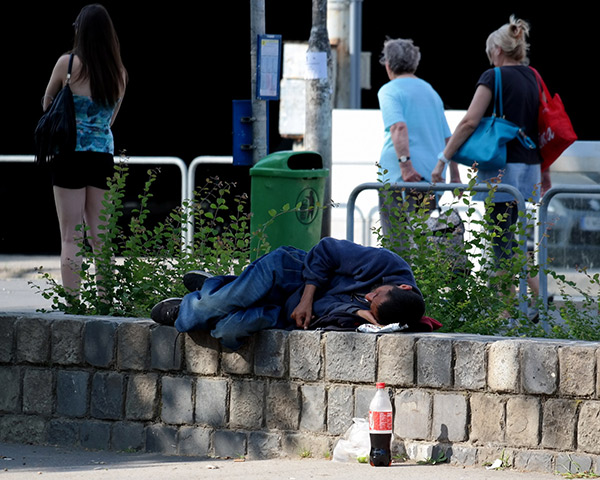

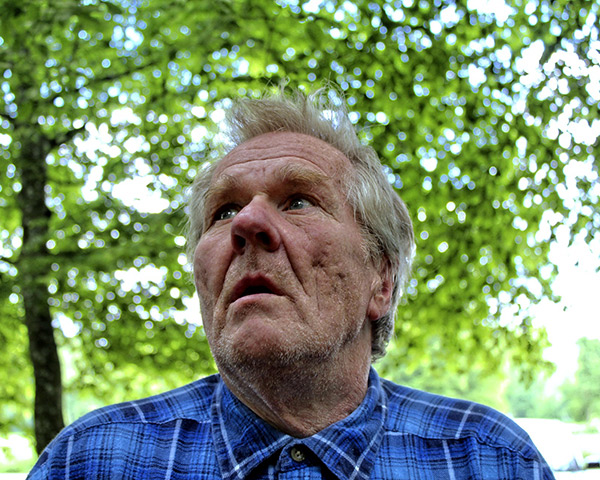
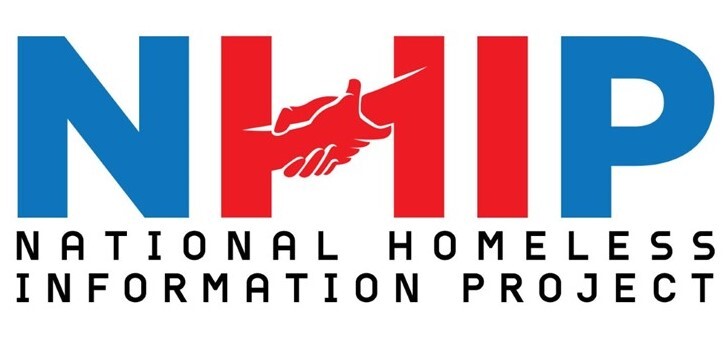

.jpg)
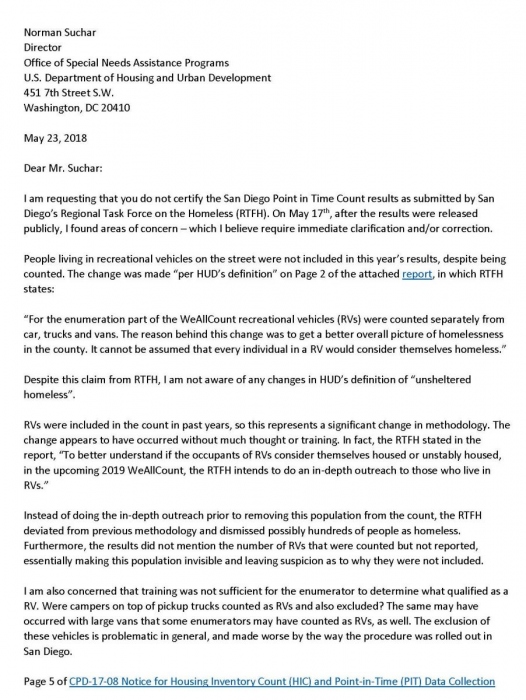
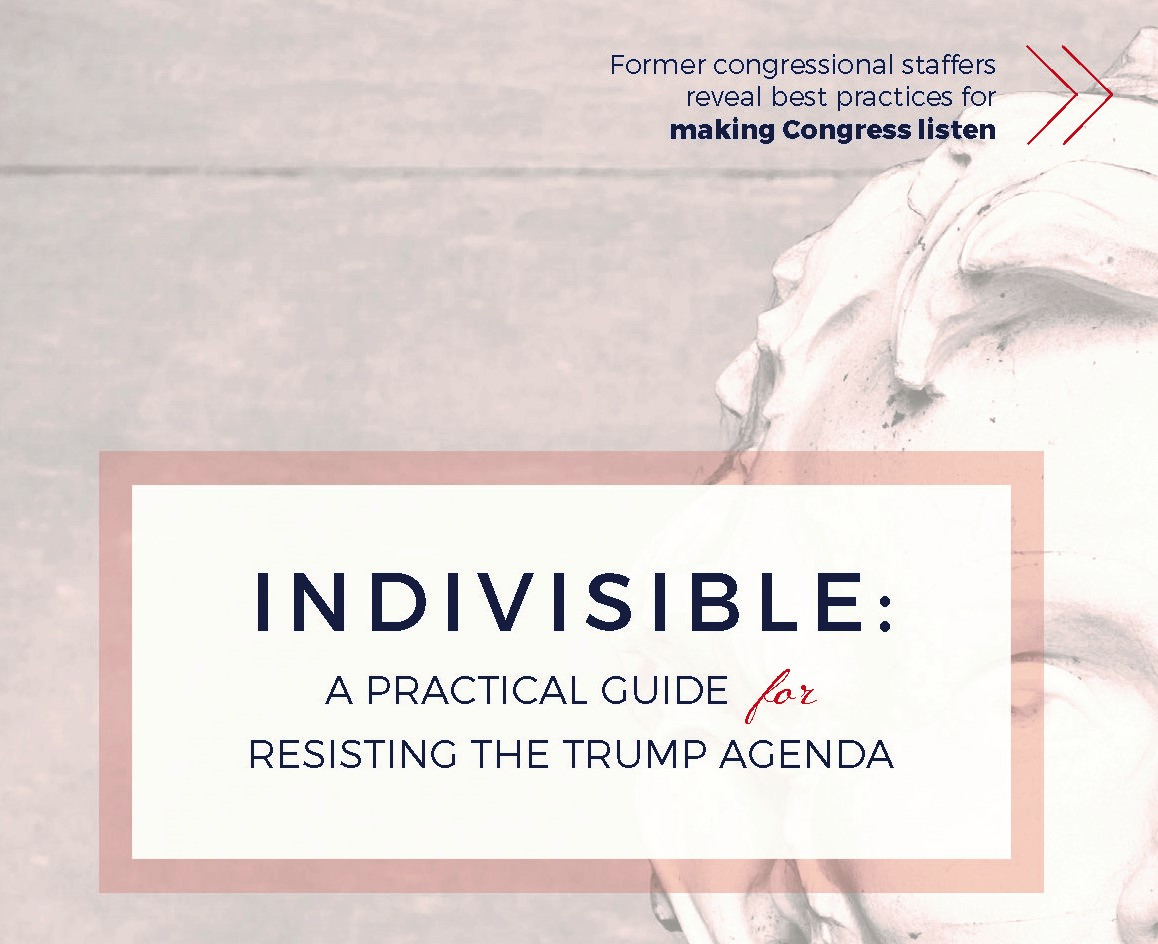
A grassroots collaboration sharing information and knowledge about homeless services